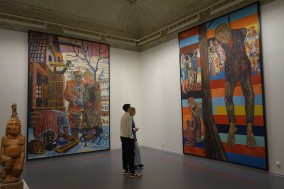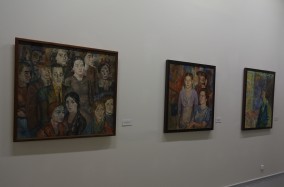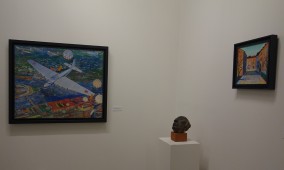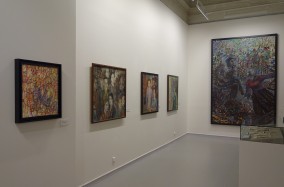Exhibition «The School of Filonov»
“The Collective of Masters of Analytical Art. The School of Filonov” existed from the summer of 1925 until the master’s death in December 1941. The school’s work was based on the idea of teamwork. The Charter reads: “Professional, ideological, strategic and political provisions adopted by the collective as the basis of its action, are binding for any member of the association.” In addition, members of the association were forbidden to be members of any other grouping and to contribute to their exhibitions. The unity of the method required complete dedication and spiritual unity.
Filonov’s students held several bright events, including the exhibition and design of the play The Government Inspector in the House of Press in 1927, as well as the design of the edition of the Karelo-Finnish folk epic poem Kalevala in 1932.
The exhibition in the House of Press was the first major public appearance of the Filonovs, after which the association received the status of an officially registered society “The Collective of Masters of Analytical Art (Filonov School)”. In 1928, twenty-three artists of Filonov’s school showed their works at the exhibition Modern Leningrad Art Groupings as representatives of this newly approved artistic grouping.
The current exhibition comprises four large panels from the show at the House of Press: Siberian Partisans by Yury Khrzhanovsky, Execution of a Revolutionary by Alevtina Mordvinova, A Worker Sitting at the Table by Eduard Tenisman and The Old and the New Way of Life by Sophia Zaklikovskaya.
The collection of the Russian Museum holds all eleven costume designs and the composition of the backdrop created by Andrei Sashin for the production of The Government Inspector (1927). Brought together these works by Sashin have never been shown or published before. The exhibition also includes costume designs by artists Arthur Landsberg and Nikolai Evgrafov from the collection of the St Petersburg State Museum of Theatre and Music.
Thirteen artists contributed to the design of the Karelo-Finnish epic Kalevala (1932), which became the first illustrated edition of this text in Russian.
The exhibition presents the first works of Pavel Kondratiev and Praskovya Vazhnova, created under the guidance of Filonov.
For the first time, the works by Georgy Novikov, Praskovya Vazhnova, Xenia Livchak and Mikhail Makarov, acquired by the museum in recent decades, are exhibited here as part of the Filonov School.
The State Museum of the History of St Petersburg loaned Tatyana Glebova’s sketches for Richard Wagner’s opera The Mastersingers of Nuremberg (1931–1932), which rarely appear in exhibitions. The early “Filonov” paintings by Boris Gurvich and Evgeny Kibrick from a Moscow private collection are also almost unknown to viewers.
More than one hundred works from the collection of the Russian Museum form the basis of the exhibition.
Age limit: 18+
The exhibition is organised with the support of PAO Severstal, Dobrota Severa Charitable Foundation, AO Power Machines, OOO Lenta, Nordgold and FUN&SUN tour operator.
The exhibition is held in the Marble Palace until April 15, 2024.
tags cloud
- #opening_of_a_branch
- #lecture
- #exhibition
- #virtual_exhibition
- #virtual_tour
- #online_exhibition
- #мультимедийная_выставка
- #poster_exhibition
- #online_event
- #masterclass
- #contest
- #занятие
- #festival
- #video_conference
- #round_table
- #conference
- #seminar
- #дошкольники
- #школьники
- #студенты
- #семья
- #серебряный_возраст
- #инклюзия
- #multimedia
- #Business_meeting_of_virtual_brances
- #The_Multimedia_Centre
- #Drammatika
- #деньмузеевВФРМ
- #ночьмузеевВФРМ
- #RussianMuseum130
- #RussianMuseum125
- #RussianMuseum120
- #RMcatalogues
- #Библионочь
- #книгиГРМ2019
- #игрыРМ
- #фильмыРМ
- #ночьискусствВФРМ
- #Artefact
- #100years_restorationRM
- #Peter_I_350
- #Antarctica200
- #folk_art
- #profession_restorer
- #RM_anniversary
- #SPb_anniversary
- #80летПобеды



